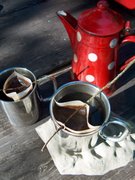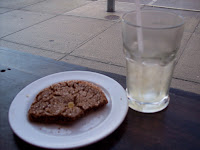a history of the world in 100 objects
 Here is something fun ... a series of 100 short (15 minute) podcasts from the BBC that tell a history of the world through a hundred objects from the British Museum.
Here is something fun ... a series of 100 short (15 minute) podcasts from the BBC that tell a history of the world through a hundred objects from the British Museum.
Telling history through things, whether it's an Egyptian mummy or a credit card, is what museums are for, and because the British Museum has collected things from all over the globe, it's not a bad place to try to tell a world history. Of course, it can only be "a" history of the world, not "the" history. When people come to the museum they choose their own objects and make their own journey round the world and through time, but I think what they will find is that their own histories quickly intersect with everybody elses, and when that happens, you no longer have a history of a particular people or nation, but a story of endless connections.
Series writer and presenter, British Museum director Neil MacGregor, speaks briefly to the issue of imperialism and why all these objects are at the British Museum instead of a in museum in the region where they were discovered but does not dwell on the politics of ownership.
You can subscribe to the podcasts or download individual episodes here: www.bbc.co.uk/podcasts/series/ahow/
You can see the gallery of objects here: www.bbc.co.uk/ahistoryoftheworld/explorerflash/#
The website gives users the opportunity to to submit items of their own for a place in world history and offers detailed information on all the objects featured in the radio programs and links to 350 other museum collections across the United Kingdom. The podcasts will be available on the website permanently for listening or downloading. There is a game called Relic, a site for schools with activities and lesson plans, and a blog that goes with the series.
The home page is a flashy mess. All the objects float around in circles that I suppose is supposed to reflect the interconnectedness of everything but it is very difficult to navigate if you are looking for a specific objects. If you want to see the objects that go with each podcast, go to the 'Programmes' page. There you will see a 'see object' link to the far right of each episode. If you click on this link, it will take you to the specific object in the AHOW gallery.
Someone has created a Wikipedia page about the series. If you scroll down to the Objects list you can see all the objects in the order of the podcasts.
- If you click on the blue words, you will see a wikipedia page about that place or thing.
- If you click on the first number after the the name of the object, you will be taken to the AHOW gallery page for that object.
- If you click on the second number after the name of the object you will be taken to the British Museum page for that object.
Warning: This series can become addictive. Also -- the listening part is only 15 minutes but that 15 minutes can easily turn into hours of clicking through the links associated with each object.
P.S. I just read Wendell's post for today and was reminded that it is Family Literacy Day. To celebrate that, listen to the podcast with someone in your family. Or a friend. Or your cat.












